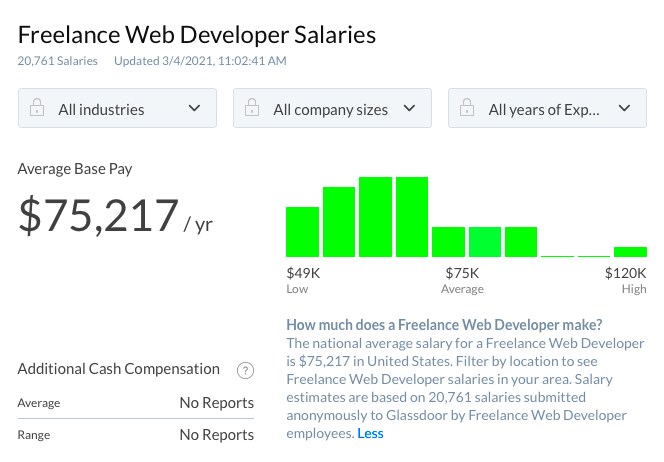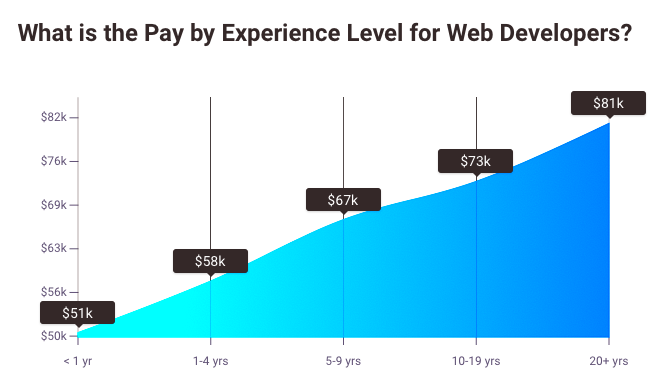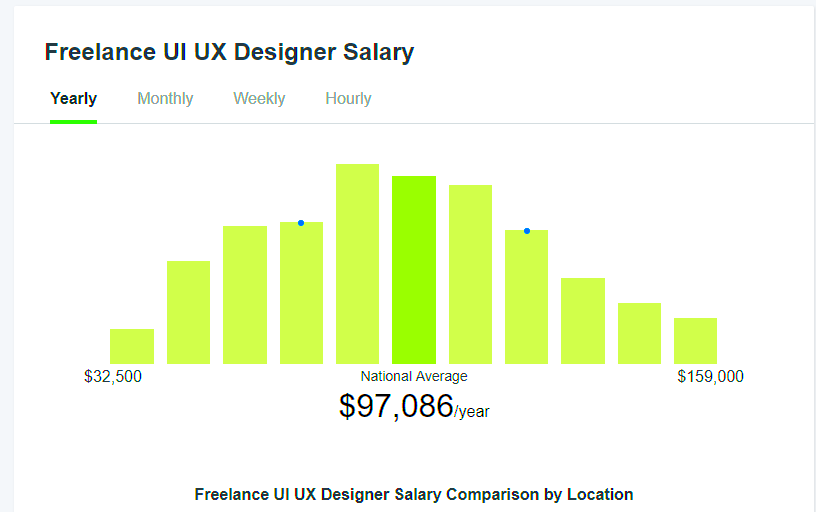Freelance web designers can earn a wide range of incomes, depending on several factors. Understanding these factors can help you better estimate how much you could earn in this field. Some web designers earn a steady income, while others may see fluctuations due to project-based work. In general, freelance web designers have the potential to earn more than salaried employees, but it also comes with its own set of challenges. Let’s explore what influences a freelance web designer's income and how to navigate this career path successfully.
Factors That Affect Freelance Web Designer Income

Several factors can influence how much a freelance web designer earns. These include experience, skills, the types of clients they work with, and the location in which they operate. Understanding these factors can help you target your efforts and increase your earning potential.
- Experience: More experienced designers often charge higher rates due to their established portfolio and proven skills.
- Skills and Specializations: Specialized skills such as e-commerce, user experience (UX) design, or mobile design can attract higher-paying clients.
- Client Type: Working with larger corporations or high-budget clients generally leads to higher earnings compared to small businesses or individuals.
- Location: Earnings may vary based on your geographical location. Designers in countries with a higher cost of living typically charge more.
- Workload and Project Type: Taking on more projects or working on high-demand projects can boost your earnings.
Also Read This: How to Write an Ad in Fiverr for Buyer Requests
Typical Rates for Freelance Web Designers by Experience Level

The rates that freelance web designers charge can vary greatly based on their experience level. Newer designers typically charge lower rates, but as they gain more experience and build their portfolios, they can command higher fees. Below is a general breakdown of typical rates based on experience:
| Experience Level | Hourly Rate (USD) | Project Rate (USD) |
|---|---|---|
| Beginner (0-2 years) | $25 - $50 | $500 - $1,000 |
| Intermediate (2-5 years) | $50 - $100 | $1,000 - $3,000 |
| Experienced (5+ years) | $100 - $200+ | $3,000 - $10,000+ |
Rates will also depend on the complexity of the project, the reputation of the designer, and the client’s budget. For example, a beginner designer may charge $500 for a basic website, while an experienced designer might charge $10,000 or more for a complex, customized site with advanced features.
Also Read This: How Does Fiverr Pay Freelancers?
Hourly vs. Project-Based Pricing for Web Designers

As a freelance web designer, you’ll likely face the decision of whether to charge by the hour or by the project. Both pricing methods have their advantages and can suit different types of work. The choice between hourly and project-based pricing depends on your experience, the type of projects you take on, and your personal preferences. Let’s break down the pros and cons of each to help you decide which one is best for your business.
Hourly Pricing is a common choice for designers who are just starting out or working on projects where the scope isn’t clearly defined. This method allows you to charge for every hour worked, which can be helpful if you’re unsure how long a project might take. However, it also means your income is directly tied to how many hours you work.
Pros of Hourly Pricing:
- Flexibility: You can adjust the rate based on how much work is required.
- Clear Compensation: You’re paid for every hour worked, which can be useful for small projects or changes.
Cons of Hourly Pricing:
- Income Variability: If the project takes longer than expected, it can affect your earnings.
- Less Incentive to Work Efficiently: The longer you take, the more you earn, which can discourage speed.
Project-Based Pricing involves setting a fixed price for the entire project, regardless of how many hours it takes. This pricing method is often preferred for larger projects where you can estimate the amount of time and effort needed upfront.
Pros of Project-Based Pricing:
- Predictable Income: You know exactly how much you’ll earn from each project.
- Efficiency Rewarded: The faster you complete the work, the more you can earn per hour.
Cons of Project-Based Pricing:
- Scope Creep: If the client requests additional work, you may need to negotiate extra charges.
- Risk of Underpricing: If you underestimate the effort, you might end up earning less than you hoped.
Also Read This: How to Buy Fiverr Stock: A Step-by-Step Guide
Comparing Freelance Web Designer Earnings in Different Countries
Freelance web designer earnings can vary significantly depending on the country in which you’re located. Factors such as cost of living, market demand, and regional industry standards influence how much you can charge for your services. Let’s take a look at how freelance web designer earnings compare across different countries.
1. United States: In the U.S., freelance web designers earn some of the highest rates globally. The average hourly rate can range from $50 to $150 or more, depending on experience and expertise. Large cities like New York or San Francisco often have higher rates due to the higher cost of living and demand for skilled designers.
2. United Kingdom: Freelance web designers in the UK typically earn between £30 and £100 per hour. While rates are lower than in the U.S., the demand for web design services remains strong, especially in major cities like London.
3. India: Freelance web designers in India generally charge lower rates due to the lower cost of living. Hourly rates often range from ₹500 to ₹2,000, although highly skilled designers may charge more for complex projects.
4. Australia: In Australia, web designers can charge between AUD $50 and $120 per hour. The market is competitive, but there’s a steady demand for web design services in both urban and regional areas.
5. Eastern Europe: In countries like Ukraine, Poland, and Romania, rates are lower than in Western Europe, with hourly rates typically between $25 and $75. However, the cost of living is also much lower, which allows freelancers to earn a comfortable income relative to their expenses.
Table: Average Hourly Rates for Freelance Web Designers
| Country | Hourly Rate (USD) |
|---|---|
| United States | $50 - $150+ |
| United Kingdom | $40 - $100 |
| India | $7 - $30 |
| Australia | $35 - $80 |
| Eastern Europe | $25 - $75 |
Also Read This: How to Delete Fiverr Account from Mobile
How to Increase Your Income as a Freelance Web Designer
Increasing your income as a freelance web designer isn’t just about raising your rates. While charging more is important, there are other strategies that can help you grow your business and attract higher-paying clients. Here are some practical ways to boost your income:
1. Build a Strong Portfolio: A well-organized portfolio showcasing your best work is crucial to attracting high-paying clients. Make sure it highlights the variety of your skills and the results you’ve achieved for past clients.
2. Specialize in a Niche: Specializing in a particular type of design, such as e-commerce websites or user experience (UX) design, can help you stand out and justify higher rates. Clients often pay more for specialized expertise.
3. Upsell Additional Services: Offer additional services like search engine optimization (SEO), website maintenance, or ongoing updates. This allows you to earn more from each client over time.
4. Improve Your Skills: The more skills you have, the more valuable you are as a designer. Invest in learning new technologies, tools, and design techniques to stay ahead of the competition.
5. Network and Build Relationships: Networking can help you connect with clients who are willing to pay more for quality work. Attend industry events, engage on social media, and reach out to potential clients to build strong relationships.
6. Focus on Client Retention: Instead of constantly seeking new clients, focus on keeping your existing clients happy. Offering excellent customer service and regularly checking in with past clients can lead to repeat business, which is often more lucrative.
Also Read This: How to Build a Career as a Freelance Translator
Challenges Freelance Web Designers Face in Growing Their Earnings
While being a freelance web designer offers flexibility and the potential for high earnings, there are several challenges that can make it difficult to grow your income. These challenges often revolve around competition, inconsistent income, and the pressures of managing multiple aspects of your business. Understanding and overcoming these obstacles can help you increase your earnings in the long run.
1. Competition: Freelance web design is a competitive industry, and finding clients can be tough, especially when you're just starting out. There are many designers offering similar services, which makes it harder to stand out. However, by focusing on building a strong portfolio and developing a niche, you can differentiate yourself.
2. Inconsistent Income: Unlike salaried jobs, freelancing doesn’t guarantee a steady paycheck. Income can fluctuate month to month based on the number of projects you take on. If you don’t have a solid client base or long-term contracts, your earnings may not be reliable.
3. Managing Time and Business: As a freelancer, you’re responsible not only for designing but also for managing your business—marketing, invoicing, and client communication. Balancing these tasks while delivering quality work can be overwhelming and may affect your productivity and income.
4. Scope Creep: Clients may often ask for extra work beyond the agreed scope, sometimes without additional pay. Without clear project guidelines and contracts, it’s easy to end up doing more work than initially agreed upon, which can eat into your time and profits.
5. Setting the Right Rates: Setting competitive yet fair rates can be challenging. Charge too little, and you may be undervalued; charge too much, and you risk pricing yourself out of potential projects. Finding the right balance takes time and research.
Also Read This: Can I Suspend My Gig on Fiverr? Here’s What You Need to Know
FAQ on Freelance Web Designer Earnings
Freelance web design can be an exciting and lucrative career, but it comes with many questions, especially when it comes to earnings. Here are some frequently asked questions (FAQs) that can provide more insight into how much you can expect to earn and what factors influence your income.
1. How much can I expect to earn as a freelance web designer?
Your earnings can vary widely based on experience, location, skills, and the type of clients you work with. On average, freelance web designers can earn anywhere from $25 to $150 per hour, or more depending on the complexity of the project.
2. How do I set my rates?
Your rates should reflect your experience, skill level, and market demand. Research what other designers in your area charge and consider factors like your niche, the complexity of your projects, and your desired income. Starting with competitive rates and adjusting them as you gain experience is a good approach.
3. Should I charge hourly or by project?
Both pricing models have pros and cons. Hourly pricing is useful for smaller or less defined projects, while project-based pricing works well for larger, well-defined projects. It's important to understand both models and choose the one that best fits your workflow.
4. How can I increase my earnings?
You can increase your earnings by specializing in a niche, improving your skills, offering additional services (like SEO or maintenance), building a strong portfolio, and networking to find higher-paying clients.
5. Do I need to offer discounts to attract clients?
While offering discounts may attract clients in the short term, it's important not to undervalue your work. Instead, focus on showcasing your expertise, delivering excellent results, and building long-term relationships with clients. Offering discounts may set the expectation for lower rates in the future.
Final Thoughts on Freelance Web Designer Income
Freelance web design offers plenty of opportunities for those who are willing to put in the effort to grow their skills and business. While income can be inconsistent, the flexibility and potential for high earnings make it a popular career choice. By understanding the factors that influence earnings, setting the right rates, and overcoming common challenges, you can build a successful and sustainable freelance career.
Remember, growing your income as a freelance web designer takes time. Building a strong reputation, constantly improving your skill set, and networking effectively can all contribute to higher-paying opportunities. Focus on providing value to your clients, and as you gain experience, your earning potential will naturally increase.
Freelance web designers who invest in their business and stay adaptable to industry trends often find success in this dynamic field. Stay focused on your goals, and the rewards of a well-established freelance career will follow.




